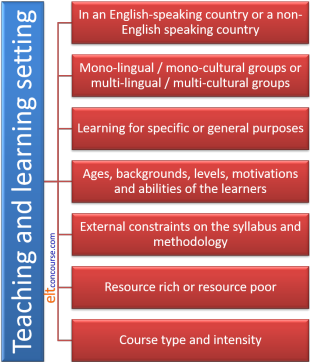Delta Module Two: Learning and teaching problems

This short guide is concerned with meeting the Delta criterion 3b) for the background essay which states that you have to show:
awareness of a range of learning and teaching problems occurring in a range of learning contexts
Actually, you have to do a bit more than show awareness,
you have to be able to describe, and propose solutions (later) for,
a range of problems in a range of
contexts.
Elsewhere, we have glossed this criterion as meaning that you
need to:
- Consider your own setting
- Think outside your own setting to show that you are aware of other possibilities
- Know how other languages work both in terms of systems and skills (not just your own learners' languages)
 |
Your setting and others |
Settings vary. Here's what you need to consider:

The easiest way to approach this is to contrast and compare your setting with others that you have worked in, imagined, considered or read about.
In each section, there are things to consider because you have to
focus on the issue of learning and
teaching problems.
Before you go on, consider what problems for learning and teaching
might be associated with the areas identified above and then click
on the
![]() for some ideas. You may think of things not in this
list. That's good, too.
for some ideas. You may think of things not in this
list. That's good, too.
| The
language(s) spoken outside your classroom |
Bear in mind that the overwhelming majority of
learners of English do not have ready access to a
native-English-speaking setting beyond the doors of your
classroom.
Current estimates vary but a widely accepted figure is that over one billion people are actively learning English worldwide. Of these, very few are studying the language in an Anglophone country. For teachers and learners outside an Anglophone setting, there are some obvious issues and one advantage:
There are issues for those working within Anglophone settings, too:
|
| Mono- vs.
multi- lingual / cultural groups |
While multi-cultural groups are may be able to
facilitate cross-cultural and cross linguistic
activities for everyone's benefit, there are other, less
positive factors:
|
| Purposes for
learning |
It is easier to construct a syllabus for learners
who share purposes for learning and also easier to
prioritise the skills they will require.
Learners with no particular reason for learning are harder to cater for as their needs are unpredictable or unknown at this stage. Teaching English for Specific Purposes is often very challenging at lower levels because the learners have not yet mastered the basics of certain skills and systems. |
| The
characteristics of the learners |
Older learners often have a good idea of what they
need to learn and are tolerant of activities which are
not immediately entertaining and engaging providing they
can see the long-term benefits. On the other hand,
they may have strong expectations concerning the 'right'
way to learn and be resistant to innovation.
Younger learners are often happy with innovation but need greater task motivation as their tolerance of delayed gratification is not their strongest virtue. In both cases, grammar and structure may be over- or under-valued. Large variations in social and learning backgrounds may make the selection of engaging topics more difficult and vice versa. Mixed ability classes impose the need for greater differentiation of activity and task types. Motivational factors come into play with the more varied the motivational types of the learners, the greater is the need for variation in task types and topics. |
| The
characteristics of the language or skill you are teaching |
This is where you make specific and traceable
reference to your analysis.
In that section, where the focus is on skills or systems, you have (of course) identified some specific difficulties and they can be of two sorts:
You may find references on this site to how other languages deal with a range of systems issues in English helpful. A section of the A-Z index on this site has links to guides which consider such matters. |
| External
constraints |
The backwash effect of teaching to examinations is
rarely conducive to the introduction of innovation and
variety in materials, tasks and topics.
If the curriculum or syllabus is imposed by factors distant from the classroom, either may not be relevant or appropriate to the learners and lead to frustration or unrealistic aims. |
| Resources |
Rich resources allow for greater variation but there
is the danger of using materials and equipment for their
own sakes rather than focus on the appropriacy of the
techniques and materials.
Resource-poor environments place excessive demands on the teacher to be the source of language and skills. ten regard grammar as a single interconnected system, all of which has to be learnt if it is to work properly. This is an illusion. Grammar is not something like a car engine, where a fault in one component such as the ignition or fuel supply can cause a complete breakdown. It is more realistic to regard grammar as an accumulation of different elements. |
| Course
intensity |
A Groups meeting only infrequently (say, once a week
for an hour) need greater amounts of recycling and some
way to maintain continuity of learning between lessons.
The role of extra-mural learning and practice is
enhanced.
Intensive courses may result in tired and demotivated learners who crave variety and cannot focus on materials and activities. |
No list like this can be exhaustive so you will need to consider your own setting and identify the advantages and disadvantages inherent in it for both the teacher's role and the students' needs.
 |
WARNING |
Do not focus in too much detail on the particular class you have in mind to teach for the assignment. Considerations of individuals and classes belongs in the Commentary to the lesson plan. Here you must take a broader view of settings in which find yourself and those beyond your own current experience.
Here are some examples of what to write and what to avoid:
| Do not write | Prefer | because |
| My class is made up of adult professional people who need these turn-taking skills in their work places. | With adult professional learners such
as I am teaching, the need for in-work interactions with
colleagues and superiors is very important because the
businesses they work in use English as the lingua franca.
However, all learners, especially those who live and work or
study (or intend to) in a native-speaking setting need to
master turn-taking skills if they are successfully to take
part in context-specific or more general social
interactions. Turn-taking, even in English, in non-English speaking settings is, however, often constrained not by the norms of Anglophone cultures but by the surrounding culture's norms and this presents difficulties. Additionally, opportunities to practise the skill outside the classroom will be rarer in such cases and this needs to be compensated for in the classroom with more opportunities for practice (see below, section 4.3). |
You are demonstrating that you know
that speaking skills are variable across cultures and you
realise some of the implications of this. You are also referring to pedagogic solutions which you will later discuss. (Do not forget to do so.) |
| I teach my current class for one hour every week so the learners often forget items taught from week to week. | Grammatical and lexical structures need constant recycling in order to be fixed in learners' long-term memories. Some estimates (e.g., Conti, 1997: 243) suggest new lexical items need to be encountered 5 to 8 times to ensure learning. In my setting, in which I only teach my groups for one hour a week, this is particularly challenging because of the gap in time between lessons and the opportunities this provides to forget items taught. On more intensive courses, this problem is less apparent because items can be recycled more frequently with shorter gaps between sessions. (See 4.4 for a proposed solution.) | You are demonstrating awareness of
cognitive and memory constraints in different settings. You have done some research. |
| My school is very well equipped so the use of web-based video resources is appropriate and effective. | In
well-resourced teaching settings, such as I am privileged to
work, the availability of web-based video recordings of
different forms of presentations is a boon in terms of
getting learners to notice the staging analysed above. In less well-resourced environments, however, this is not possible and a constraint on the teacher is imposed which may mean that it is less easy to exemplify the staging and structure of academic presentations. In section 4.5, I propose a solution. |
You are considering other settings outside your own and using teacherly intuition to imagine the teaching difficulty this imposes. |
| Because my students live and work in Sydney they need interactional skills daily. | Learners who
are permanently or temporarily resident in a
native-English-speaking country clearly need these skills on
a daily basis. This is not, however, the case elsewhere and opportunities for practice are concomitantly lower. However, even learners in non-native-English speaking environments may often need to interact with other first- or second-language speakers of English (for example, in countries where English is an official or de facto national language such as it is in many African states). The ability, therefore to recognise when to combine a Response with an Initiation is still something that needs to be taught rather than assumed. |
Because you are getting away from your own setting and considering how the issues might be different elsewhere. Even if you have never taught in the settings you mention, the fact that you have considered them rationally is a strong point to make. |
| My class is preparing for the IELTS examination. | Currently, I
am teaching learners preparing to take IELTS who often fail
to distinguish between these two genres and produce texts
which are unconventional and confusing for the reader. Beyond this setting, however, the IELTS examination is intended to test whether the skills can be deployed in real-life settings so the generic structures I have identified in this essay are still difficult for them to acquire yet important. |
Because you have made it clear that an examination which your, or other, learners are preparing to take is not an end in itself but a means of demonstrating abilities to perform in real-life settings. |
| My Italian learners have difficulties with these verbs because the structures do not exist in Italian. | My current
classes consist overwhelmingly of Italian speakers who, in
common with users of other Romance languages such as Spanish,
Romanian and French often avoid the use of multi-word verbs,
preferring, for example, postpone to put off
and collapse to break down. Speakers of other languages which have something akin to these structures (such as Germanic languages) will be less reluctant to learn and use them. |
You have gone beyond description to consider the implications and the learning / teaching problems and advantages that first-languages structures may give rise to. |
